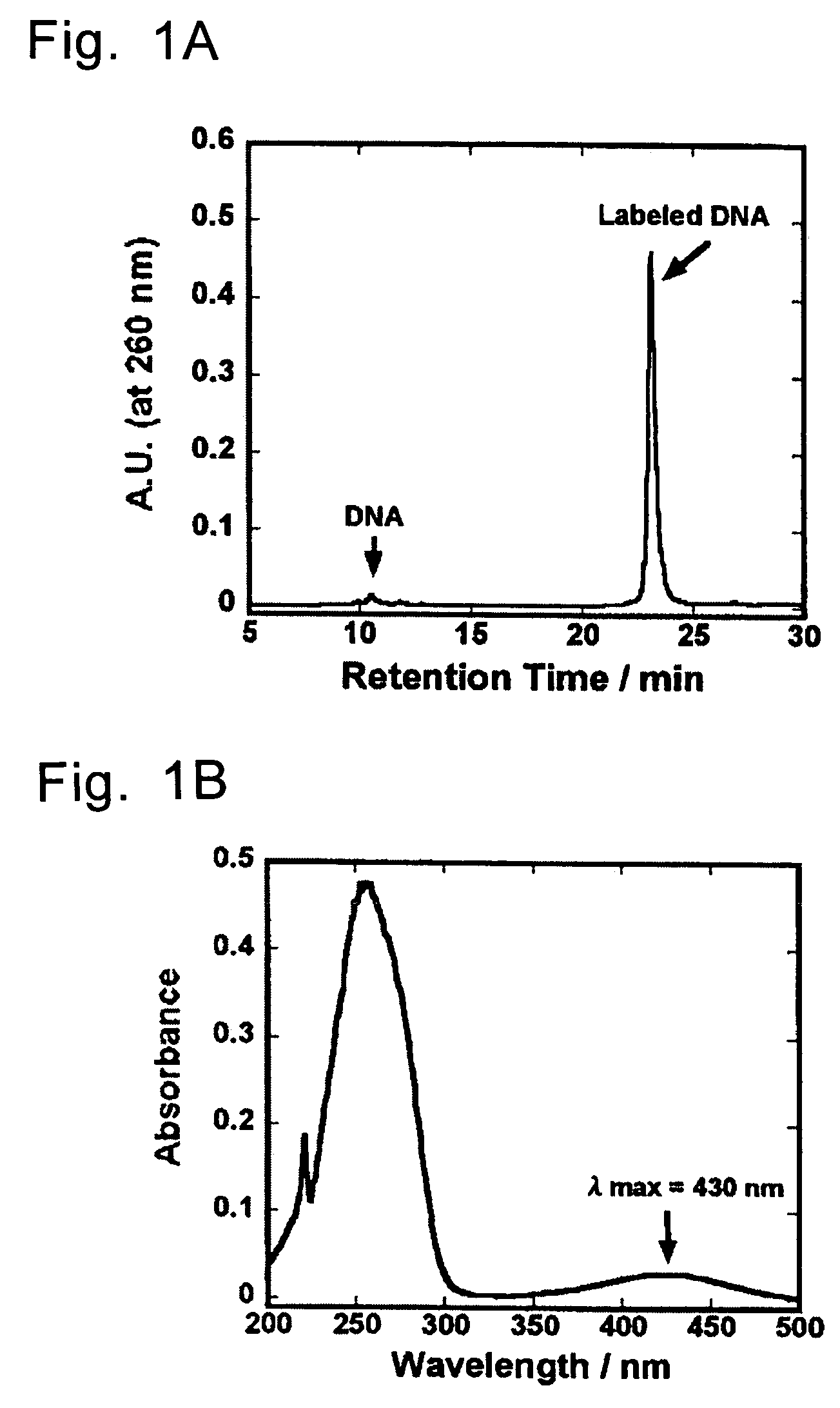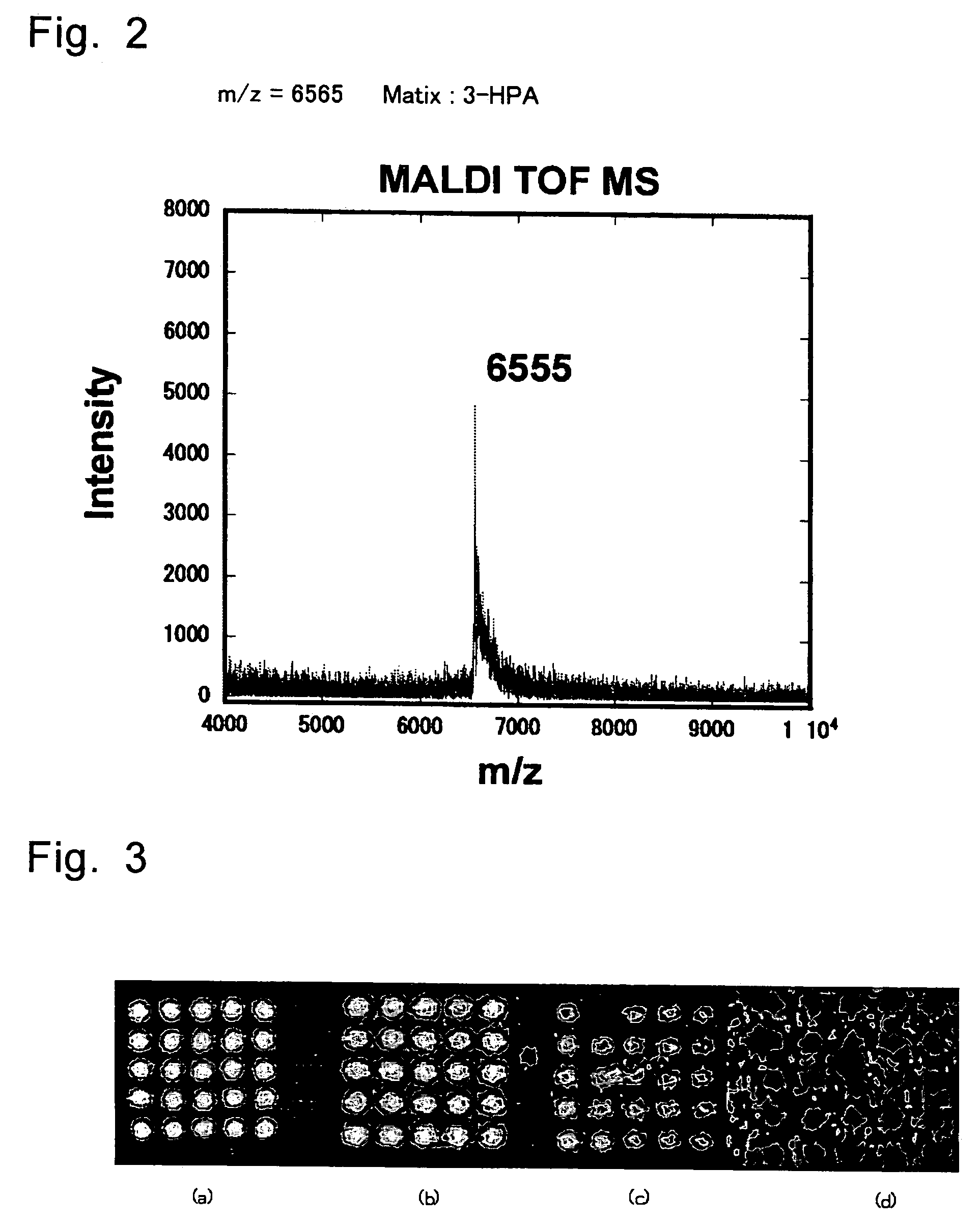Method of detecting biological molecules, and labeling dye and labeling kit used for the same
a biological and labeling technology, applied in the field of biological and labeling labeling methods, can solve the problems of high detection cost and insufficient detection sensitivity
- Summary
- Abstract
- Description
- Claims
- Application Information
AI Technical Summary
Benefits of technology
Problems solved by technology
Method used
Image
Examples
synthesis example 1
[0059]A 1,2,5-oxadiazolo-[3,4-c]pyridine derivative was used as the organic EL-dye.
[0060]The scheme for synthesis of an active ester of a 1,2,5-oxadiazolo-[3,4-c]pyridine (hereinafter, abbreviated as EL-OSu) will be shown below.
(1) Synthesis of Diketone Derivative (2)
[0061]In a 500 mL three-necked flask, 37.5 g (0.25 mol) of 4-methoxyacetophenone (1) and 0.15 g of sodium nitrite were dissolved in 100 mL of acetic acid. On a water bath, a solution prepared by dissolving 100 mL of HNO3 in 100 mL of acetic acid was added dropwise over 2 hours. Then, the mixture was stirred at room temperature for 2 days. The reaction mixture was slowly added into 500 mL of water to cause precipitation. The precipitate was filtrated and dissolved in chloroform. The chloroform phase was washed with saturated sodium bicarbonate water, and washed twice with a 10% NaCl aqueous solution. After dehydration over MgSO4, chloroform was distilled off under reduced pressure to obtain 34.5 g (yield: 78%) of oxadia...
synthesis example 2
[0066]An imidazolopyridine ethyl ester derivative was used as a organic EL-dye. The scheme for synthesis of an active ester of a imidazolopyridine ethyl ester (hereinafter, abbreviated as im-EL-OSu) will be shown below.
(1) Hydrolysis of Imidazolopyridine Ethyl Ester (1)
[0067]In a 500 mL three-necked flask, 0.5 g (1.5 mmol) of an ester 1 was dissolved in 50 mL of ethanol. To this was added 0.12 g (2.1 mol) of KOH. After heating to reflux for 5 hours, the reaction mixture was added to 50 mL of water. Into this aqueous solution, concentrated hydrochloric acid was added dropwise to adjust pH to 1 to obtain a precipitate. The precipitate was filtrated and dissolved in chloroform. The chloroform phase was washed with a 10% NaHCO3 aqueous solution and water. Chloroform was distilled off to obtain a residue. The residue was recrystallized from water to obtain 0.3 g (yield: 63%) of a carboxylic acid 2.
(2) Synthesis of Active Ester (3)
[0068]In a 50 mL three-necked flask, 0.2 g (0.6 mmol) of ...
example 1
1. Labeling of Oligonucleotide with Dye
[0069]Labeling of an oligonucleotide with a dye was conducted according to the following Scheme 4.
(Experimental Procedure)
[0070]Into 40 μl of Na2CO3 / NaHCO3 buffer (pH 9.0) containing H2N-dT2O (40 mmol) was added 12 μl of an anhydrous DMSO solution containing 5.0 μmol (2.4 mg) of an active ester of an organic EL-dye and the mixture was shaken at room temperature for 6 hours. After shaking, 0.1 M TEAA (triethylamine acetic acid) buffer (pH 7.0) was added so as to give the total volume of 1 ml, and components derived from the oligonucleotide were separated using NAP-10 column (Pharmacia Sephadex G-25). In this operation, the NAP-10 column had been equilibrated previously with 15 ml of 0.1 M TEAA buffer before use. The sample solution of which total volume had been adjusted to 1 ml was applied into in a column. After elution of 1 ml of the solution, 0.1 M TEAA buffer was charged in a volume of 1.5 ml. Immediately after this, 1.5 ml of the eluted s...
PUM
| Property | Measurement | Unit |
|---|---|---|
| temperature | aaaaa | aaaaa |
| temperature | aaaaa | aaaaa |
| temperature | aaaaa | aaaaa |
Abstract
Description
Claims
Application Information
 Login to View More
Login to View More - R&D
- Intellectual Property
- Life Sciences
- Materials
- Tech Scout
- Unparalleled Data Quality
- Higher Quality Content
- 60% Fewer Hallucinations
Browse by: Latest US Patents, China's latest patents, Technical Efficacy Thesaurus, Application Domain, Technology Topic, Popular Technical Reports.
© 2025 PatSnap. All rights reserved.Legal|Privacy policy|Modern Slavery Act Transparency Statement|Sitemap|About US| Contact US: help@patsnap.com



